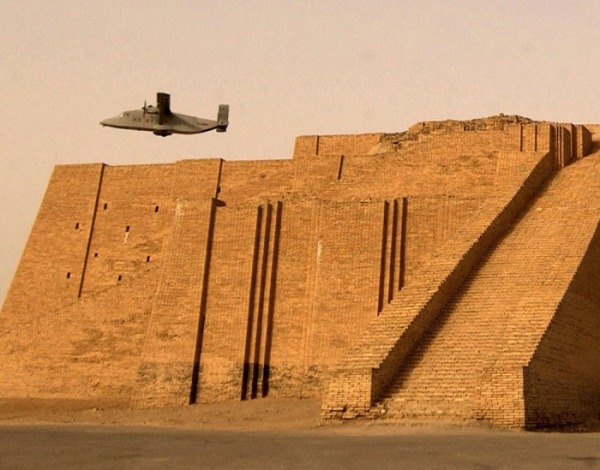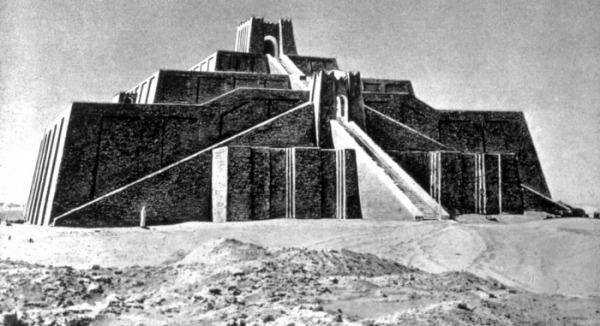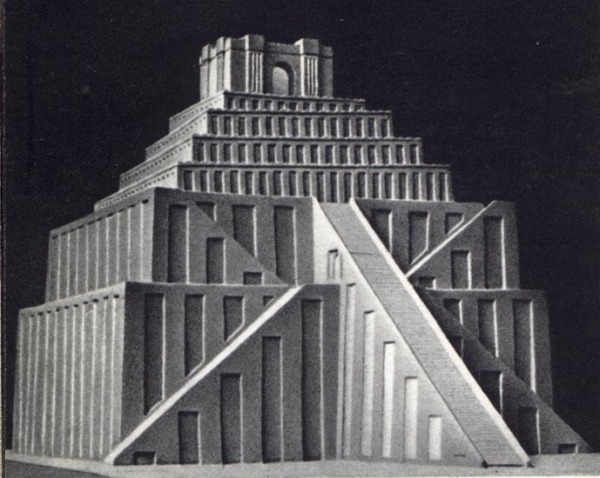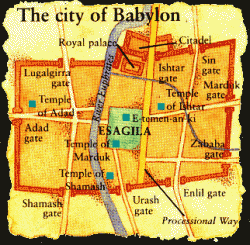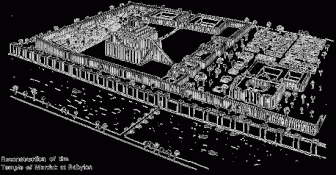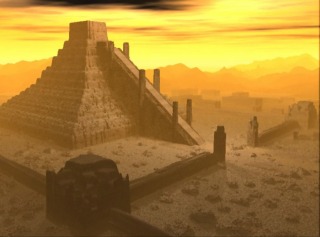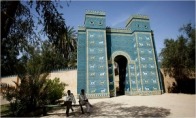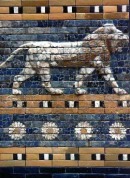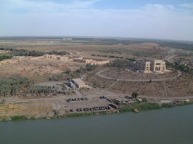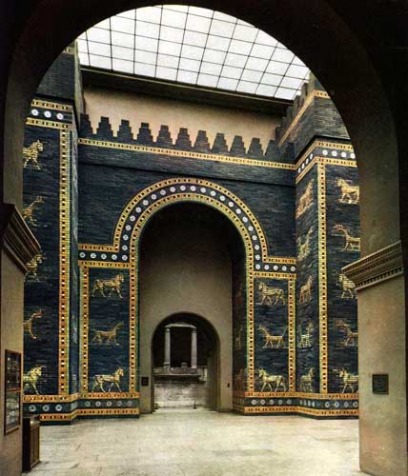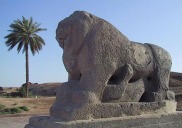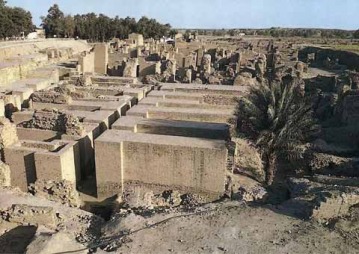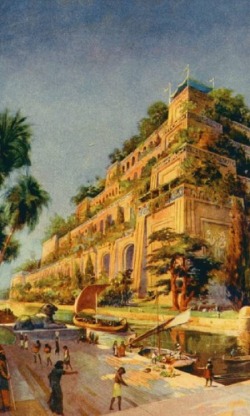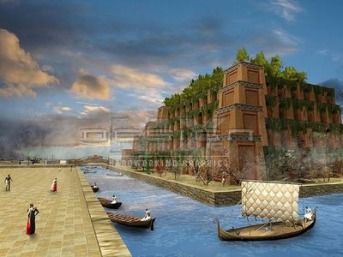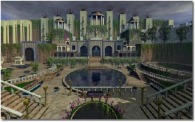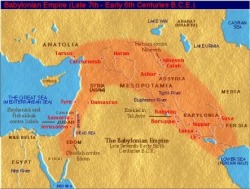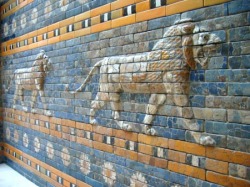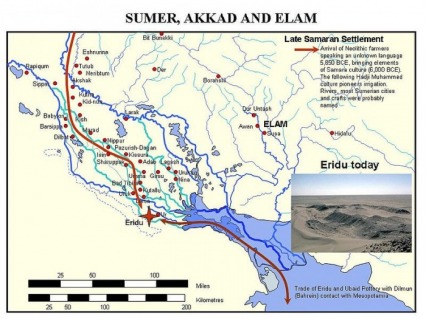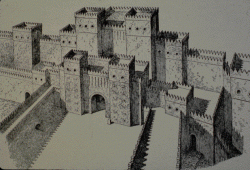Architectual.Gravitas
Ziggurats
Ziggurats (Akkadian (transliterated): ziqqurat, D-stem of zaqāru "to build on a raised area") were massive pyramidal temples built in the ancient Mesopotamian valley and western Iranian plateau, having the form of a terraced step pyramid of successively receding stories or levels. There are 32 ziggurats known at, and near, Mesopotamia. Twenty-eight of them are in Iraq, and four of them are in Iran. Notable Ziggurats include the Great Ziggurat of Ur near Nasiriyah, Iraq, the Ziggurat of Aqar Quf near Baghdad, Iraq, Chogha Zanbil in Khūzestān, Iran, the most recent to be discovered - Sialk near Kashan, Iran and others.
Ur
The Great Ziggurat ofUr (Sumerian (transliterated): Etemennigur, meaning "House whose foundation creates terror"[1]) is an ancientSumerianziggurat in Dhi Qar Province, Iraq. The ziggurat was built by the Sumerian KingUr-Nammu and his son Shulgiin approximately the 21st century BC during the Third Dynasty of Ur,[1] in dedication to the moon godNanna. The massivestep pyramid measures 210 feet (64m) in length, 150 feet (46m) in width and over 100 feet (30m) in height.
The ziggurat was a piece in a temple complex that served as an administrative center for the city, and which was thought to be the dwelling of the moon god Nanna, the patron deity of Ur, on earth. It is said that ziggurat serves as a tool to bridge the distance between the sky and the earth. The gods are believed to descend and visit the temple where only a selected group of priests and government officials may enter.[2]
The construction of the zigguratwas finished in the 21st century BC by King Shulgi, who, in order to win the allegiance of cities, proclaimed himself a god. During his 48-year reign, the city of Ur grew to be the capital of a state controlling much ofMesopotamia. Later though, the fortunes of Ur declined, and it was sacked by the Elamites in 2004 BC.[3]
King Nabonidus, thelast king of the Neo-Babylonian Empire in the 6th century BC, after "finding little left but the last stage and nothing to guide him as to the monument's original appearance", had it restored in seven stages rather than three.[4] Today, after more than 4000 years, the ziggurat is still well preserved in large parts, and partially reconstructed. It is the only major remainder ofUr in southernIraq.
The ziggurat was a piece in a temple complex that served as an administrative center for the city, and which was thought to be the dwelling of the moon god Nanna, the patron deity of Ur, on earth. It is said that ziggurat serves as a tool to bridge the distance between the sky and the earth. The gods are believed to descend and visit the temple where only a selected group of priests and government officials may enter.[2]
The construction of the zigguratwas finished in the 21st century BC by King Shulgi, who, in order to win the allegiance of cities, proclaimed himself a god. During his 48-year reign, the city of Ur grew to be the capital of a state controlling much ofMesopotamia. Later though, the fortunes of Ur declined, and it was sacked by the Elamites in 2004 BC.[3]
King Nabonidus, thelast king of the Neo-Babylonian Empire in the 6th century BC, after "finding little left but the last stage and nothing to guide him as to the monument's original appearance", had it restored in seven stages rather than three.[4] Today, after more than 4000 years, the ziggurat is still well preserved in large parts, and partially reconstructed. It is the only major remainder ofUr in southernIraq.
Ziggurats were built by the Sumerians, Babylonians, Elamites and Assyrians as monuments to local religions. The precursors of the ziggurat were raised platforms that date from theUbaid period[1] during the fourthmillennium BC. The step pyramid style began near the end of the Early Dynastic Period.[2] The latest Mesopotamian ziggurats date from the 6th century BC. Built in receding tiers upon a rectangular, oval, or square platform, the ziggurat was a pyramidal structure with a flat top. Sun-baked bricks made up the core of the ziggurat with facings of fired bricks on the outside. The facings were often glazed in different colors and may have had astrological significance. Kings sometimes had their names engraved on these glazed bricks. The number of tiers ranged from two to seven. It is assumed that they had shrines or temples at the top but there is no archaeological evidence for this and the only textual evidence is from Herodotus.[3]Access to the shrine would have been by a series of ramps on one side of the ziggurat or by a spiral ramp from base to summit. The Mesopotamian ziggurats were not places for public worship or ceremonies. They were believed to be dwelling places for the gods and each city had its own patron god. Only priests were permitted on the ziggurat or in the rooms at its base, and it was their responsibility to care for the gods and attend to their needs. The priests were very powerful members of Sumerian society. Ziggurats were usually found in the centre of villages.
CADrendering of Sialk's largest ziggurat based on archeological evidence.
One of the best-preserved ziggurats is Choqa Zanbil in western Iran. TheSialk ziggurat, in Kashan, Iran, is the oldest known ziggurat, dating to the early 3rd millennium BC. Ziggurat designs ranged from simple bases upon which a temple sat, to marvels of mathematics and construction which spanned several terraced stories and were topped with a temple.
An example of a simple ziggurat is the White Temple ofUruk, in ancient Sumer. The ziggurat itself is the base on which the White Temple is set. Its purpose is to get the temple closer to the heavens, and provide access from the ground to it via steps. The Mesopotamians believed that these pyramid temples connected heaven and earth. In fact, the ziggurat at Babylon was known as Etemenankia or "House of the Platform between Heaven and Earth".
An example of an extensive and massive ziggurat is the Marduk ziggurat, orEtemenanki, of ancient Babylon. Unfortunately, not much of even the base is left of this massive structure, yet archeological findings and historical accounts put this tower at seven multicolored tiers, topped with a temple of exquisite proportions. The temple is thought to have been painted and maintained an indigo color, matching the tops of the tiers. It is known that there were three staircases leading to the temple, two of which (side flanked) were thought to have only ascended half the ziggurat's height.
Etemenanki, the name for the structure, is Sumerian and means "The Foundation of Heaven and Earth". Most likely built by Hammurabi, the ziggurat's core was found to have contained the remains of earlier ziggurats and structures. The final stage consisted of a 15-meter hardened brick encasement constructed by KingNebuchadnezzar.
CADrendering of Sialk's largest ziggurat based on archeological evidence.
One of the best-preserved ziggurats is Choqa Zanbil in western Iran. TheSialk ziggurat, in Kashan, Iran, is the oldest known ziggurat, dating to the early 3rd millennium BC. Ziggurat designs ranged from simple bases upon which a temple sat, to marvels of mathematics and construction which spanned several terraced stories and were topped with a temple.
An example of a simple ziggurat is the White Temple ofUruk, in ancient Sumer. The ziggurat itself is the base on which the White Temple is set. Its purpose is to get the temple closer to the heavens, and provide access from the ground to it via steps. The Mesopotamians believed that these pyramid temples connected heaven and earth. In fact, the ziggurat at Babylon was known as Etemenankia or "House of the Platform between Heaven and Earth".
An example of an extensive and massive ziggurat is the Marduk ziggurat, orEtemenanki, of ancient Babylon. Unfortunately, not much of even the base is left of this massive structure, yet archeological findings and historical accounts put this tower at seven multicolored tiers, topped with a temple of exquisite proportions. The temple is thought to have been painted and maintained an indigo color, matching the tops of the tiers. It is known that there were three staircases leading to the temple, two of which (side flanked) were thought to have only ascended half the ziggurat's height.
Etemenanki, the name for the structure, is Sumerian and means "The Foundation of Heaven and Earth". Most likely built by Hammurabi, the ziggurat's core was found to have contained the remains of earlier ziggurats and structures. The final stage consisted of a 15-meter hardened brick encasement constructed by KingNebuchadnezzar.
Babylon, Iraq
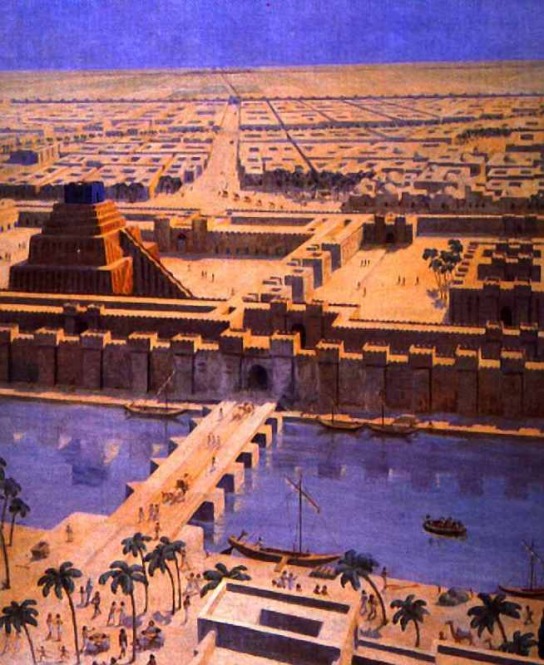
gutians_sumer_ziggurat
Babylon, IraqBabylon, the legendary city, is indeed, the most famous ancient city in the whole World. It was the capital of ten Mesopotamian dynasties starting with the dynasty of King Hammurabi (1792-1750 BC); the 6th king of the 1st dynasty; reaching prominence as the capital city of the great kingdom of Babylonia. The last dynasty at which Babylon achieved its zenith, is well known particularly of its 2nd king, Nebuchadnezzar II (605-563 BC), to whom most of Babylon's existing buildings belongs.
Babylon was renowned for its high, well-fortified walls and for the magnificence of its temples and palaces. Its famous Hanging Gardens, built by King Nebuchadnezzar II for his wife Amytas, were one of the Seven Wonders of the World. Amytas was a Medes and her home was in mountainous country, so the King reputedly had the Hanging Gardens built to allay her homesickness.
Nowadays, its ruins covers about 302 km lying on the east bank of Euphrates 90 km south of Baghdad and about 10 km north of Hilla. The most important of the standing monuments of Babylon today are the Summer and Winter Palaces of King Nebuchadnezzar II, the Ziggurat attached to it, the Street of Processions, the Lion of Babylon, and the famous Ishtar Gate.
In Akkadian times, around 2350 BC, Babylon was a small village, which in 5 or 6 centuries had grown in size and importance, mostly during the reign of the 3rd Dynasty, until it rose like a city meteor to deal the coup de grace to Sumerian authority in Mesopotamia under Amorite kings. Babylon itself became a major city-state, as the capital of the great Amorite soldier, the famous king, law-giver and social reformer King Hammurabi, with a code of common law, and a king with genuine concern for the well-being of his subjects - an unusual feature in those times.
Babylon was renowned for its high, well-fortified walls and for the magnificence of its temples and palaces. Its famous Hanging Gardens, built by King Nebuchadnezzar II for his wife Amytas, were one of the Seven Wonders of the World. Amytas was a Medes and her home was in mountainous country, so the King reputedly had the Hanging Gardens built to allay her homesickness.
Nowadays, its ruins covers about 302 km lying on the east bank of Euphrates 90 km south of Baghdad and about 10 km north of Hilla. The most important of the standing monuments of Babylon today are the Summer and Winter Palaces of King Nebuchadnezzar II, the Ziggurat attached to it, the Street of Processions, the Lion of Babylon, and the famous Ishtar Gate.
In Akkadian times, around 2350 BC, Babylon was a small village, which in 5 or 6 centuries had grown in size and importance, mostly during the reign of the 3rd Dynasty, until it rose like a city meteor to deal the coup de grace to Sumerian authority in Mesopotamia under Amorite kings. Babylon itself became a major city-state, as the capital of the great Amorite soldier, the famous king, law-giver and social reformer King Hammurabi, with a code of common law, and a king with genuine concern for the well-being of his subjects - an unusual feature in those times.
US MILITARY IN BABYLON
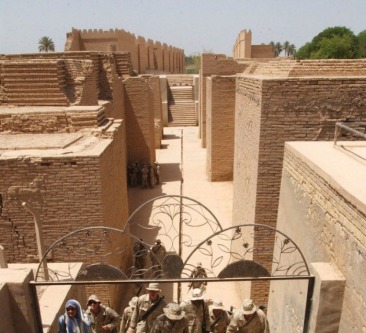
In the 1980s Mr. Hussein ordered the reconstruction of Nebuchadnezzar’s palace and other buildings, using cheap bricks on foundations built 2,600 years ago. Many were stamped with a tribute to the “Protector of Great Iraq” in the way Nebuchadnezzar marked bricks with his own stamp in cuneiform, still visible today.
Archaeologists were appalled, but could hardly complain at the time. Such is not the case with the American and Polish troops who occupied the site from 2003 to 2004. The work they carried out to turn the area into a base, as reported by a British Museum study, provoked international outrage, though the extent of the damage is a matter of debate and perspective.
One thing officials agree on is blaming the Americans. Mr. Rashid, in a conspiratorial and anti-Semitic vein, suggested that Jews stationed with the Polish troops might have deliberately singled out the site because of their captivity in Babylon. The director of the ruins, Maryam Musa, who has worked in Babylon for 30 years, said the damage could never be repaired or adequately compensated for.
Asked who did worse by Babylon, Mr. Hussein or the Americans, however, she became taciturn. “Is it necessary to ask such a question?” she said uncomfortably, and declined to answer.
Mohammed Taher, an archaeologist and former director of the ruins who opposes reopening Babylon, said what was being done now was little better than what had been done before. “I would like to rebuild Babylon again for scientific research, not like Saddam,” he said as he guided visitors through the remains of Ishtar Gate with bas reliefs of Babylon’s gods; the Temple of Ninmakh; the Processional Way, with brick paving stones mortared with bitumen; and a symbol of Iraq itself, the Lion of Babylon, a 2,600-year-old sculpture.
Archaeologists were appalled, but could hardly complain at the time. Such is not the case with the American and Polish troops who occupied the site from 2003 to 2004. The work they carried out to turn the area into a base, as reported by a British Museum study, provoked international outrage, though the extent of the damage is a matter of debate and perspective.
One thing officials agree on is blaming the Americans. Mr. Rashid, in a conspiratorial and anti-Semitic vein, suggested that Jews stationed with the Polish troops might have deliberately singled out the site because of their captivity in Babylon. The director of the ruins, Maryam Musa, who has worked in Babylon for 30 years, said the damage could never be repaired or adequately compensated for.
Asked who did worse by Babylon, Mr. Hussein or the Americans, however, she became taciturn. “Is it necessary to ask such a question?” she said uncomfortably, and declined to answer.
Mohammed Taher, an archaeologist and former director of the ruins who opposes reopening Babylon, said what was being done now was little better than what had been done before. “I would like to rebuild Babylon again for scientific research, not like Saddam,” he said as he guided visitors through the remains of Ishtar Gate with bas reliefs of Babylon’s gods; the Temple of Ninmakh; the Processional Way, with brick paving stones mortared with bitumen; and a symbol of Iraq itself, the Lion of Babylon, a 2,600-year-old sculpture.
Halliburton Destroys Babylon Posted March 25, 2005

The U.S.-led destruction on the ancient city is one of the most ‘reckless acts of cultural vandalism.’
The sterile term “collateral damage” justifiably brings to mind the human tragedy of war.
But the devastating and wanton damage inflicted on the ancient city of Babylon by U.S.-led military forces gives another meaning to the term.
In this case, we are witnessing violence against one of the world’s greatest cultural treasures.
Babylon’s destruction, according to The Guardian, “must rank as one of the most reckless acts of cultural vandalism in recent memory.”When Camp Babylon was established by U.S.-led international forces in April 2003, leading archeologists and international experts on ancient civilizations warned of potential peril and damage.
It was “tantamount to establishing a military camp around the Great Pyramid in Egypt or around Stonehenge in Britain,” according to a damning report issued in January by the British Museum.
The sterile term “collateral damage” justifiably brings to mind the human tragedy of war.
But the devastating and wanton damage inflicted on the ancient city of Babylon by U.S.-led military forces gives another meaning to the term.
In this case, we are witnessing violence against one of the world’s greatest cultural treasures.
Babylon’s destruction, according to The Guardian, “must rank as one of the most reckless acts of cultural vandalism in recent memory.”When Camp Babylon was established by U.S.-led international forces in April 2003, leading archeologists and international experts on ancient civilizations warned of potential peril and damage.
It was “tantamount to establishing a military camp around the Great Pyramid in Egypt or around Stonehenge in Britain,” according to a damning report issued in January by the British Museum.
HANGING GARDENS OF BABYLON
The approach to the Garden sloped like a hillside and the several parts of the structure rose from one another tier on tier... On all this, the earth had been piled... and was thickly planted with trees of every kind that, by their great size and other charm, gave pleasure to the beholder... The water machines [raised] the water in great abundance from the river, although no one outside could see it. Diodorus Siculus
----------------------------------------------------------------------------------------------------------------------------------------------------------------
Fruits and flowers... Waterfalls... Gardens hanging from the palace terraces... Exotic animals... This is the picture of the Hanging Gardens of Babylon in most people's minds. It may be surprising to know that they might have never existed except in the minds of Greek poets and historians!
LOCATION------------------------------------------------------------------------------------------------------------------------------------------------------------------------------------------------------------------
On the east bank of the River Euphrates, about 50 km south of Baghdad, Iraq.
HISTORY--------------------------------------------------------------------------------------------------------------------------------------------------------------------------------------------------------------------
The Babylonian kingdom flourished under the rule of the famous King, Hammurabi (1792-1750 BC). It was not until the reign of Naboplashar (625-605 BC) of the Neo-Babylonian dynasty that the Mesopotamian civilization reached its ultimate glory. His son, Nebuchadnezzar II (604-562 BC) is credited for building the legendary Hanging Gardens. It is said that the Gardens were built by Nebuchadnezzar to please his wife or concubine who had been "brought up in Media and had a passion for mountain surroundings". While the most descriptive accounts of the Gardens come from Greek historians such as Berossus and Diodorus Siculus, Babylonian records stay silent on the matter. Tablets from the time of Nebuchadnezzar do not have a single reference to the Hanging Gardens, although descriptions of his palace, the city of Babylon, and the walls are found. Even the historians who give detailed descriptions of the Hanging Gardens never saw them. Modern historians argue that when Alexander's soldiers reached the fertile land of Mesopotamia and saw Babylon, they were impressed. When they later returned to their rugged homeland, they had stories to tell about the amazing gardens and palm trees at Mesopotamia.. About the palace of Nebuchadnezzar.. About the Tower of Babel and the ziggurats. And it was the imagination of poets and ancient historians that blended all these elements together to produce one of the World Wonders. It wasn't until the twentieth century that some of the mysteries surrounding the Hanging Gardens were revealed. Archaeologists are still struggling to gather enough evidence before reaching the final conclusions about the location of the Gardens, their irrigation system, and their true appearance. Some recent researchers even suggest that the Hanging Gardens were built by Senaherib, not by Nebuchadnezzar II (ca. 100 years earlier). Detailed descriptions of the Gardens come from ancient Greek sources, including the writings of Strabo and Philo of Byzantium. Here are some excerpts from their accounts:
================================================================================================================
"The Garden is quadrangular, and each side is four plethra long. It consists of arched vaults which are located on checkered cube-like foundations.. The ascent of the uppermost terrace-roofs is made by a stairway..."
================================================================================================================
"The Hanging Garden has plants cultivated above ground level, and the roots of the trees are embedded in an upper terrace rather than in the earth. The whole mass is supported on stone columns... Streams of water emerging from elevated sources flow down sloping channels... These waters irrigate the whole garden saturating the roots of plants and keeping the whole area moist. Hence the grass is permanently green and the leaves of trees grow firmly attached to supple branches... This is a work of art of royal luxury and its most striking feature is that the labor of cultivation is suspended above the heads of the spectators."More recent archaeological excavations at the ancient city of Babylon in Iraq uncovered the foundation of the palace. Other findings include the Vaulted Building with thick walls and an irrigation well near the southern palace. A group of archaeologists surveyed the area of the southern palace and reconstructed the Vaulted Building as the Hanging Gardens. However, the Greek historian Strabo had stated that the gardens were situated by the River Euphrates. So others argue that the site is too far from the Euphrates to support the theory since the Vaulted Building is several hundreds of meters away. They reconstructed the site of the palace and located the Gardens in the area stretching from the River to the Palace. On the river banks, recently discovered massive walls 25 m thick may have been stepped to form terraces... the ones described in Greek references.
----------------------------------------------------------------------------------------------------------------------------------------------------------------
Fruits and flowers... Waterfalls... Gardens hanging from the palace terraces... Exotic animals... This is the picture of the Hanging Gardens of Babylon in most people's minds. It may be surprising to know that they might have never existed except in the minds of Greek poets and historians!
LOCATION------------------------------------------------------------------------------------------------------------------------------------------------------------------------------------------------------------------
On the east bank of the River Euphrates, about 50 km south of Baghdad, Iraq.
HISTORY--------------------------------------------------------------------------------------------------------------------------------------------------------------------------------------------------------------------
The Babylonian kingdom flourished under the rule of the famous King, Hammurabi (1792-1750 BC). It was not until the reign of Naboplashar (625-605 BC) of the Neo-Babylonian dynasty that the Mesopotamian civilization reached its ultimate glory. His son, Nebuchadnezzar II (604-562 BC) is credited for building the legendary Hanging Gardens. It is said that the Gardens were built by Nebuchadnezzar to please his wife or concubine who had been "brought up in Media and had a passion for mountain surroundings". While the most descriptive accounts of the Gardens come from Greek historians such as Berossus and Diodorus Siculus, Babylonian records stay silent on the matter. Tablets from the time of Nebuchadnezzar do not have a single reference to the Hanging Gardens, although descriptions of his palace, the city of Babylon, and the walls are found. Even the historians who give detailed descriptions of the Hanging Gardens never saw them. Modern historians argue that when Alexander's soldiers reached the fertile land of Mesopotamia and saw Babylon, they were impressed. When they later returned to their rugged homeland, they had stories to tell about the amazing gardens and palm trees at Mesopotamia.. About the palace of Nebuchadnezzar.. About the Tower of Babel and the ziggurats. And it was the imagination of poets and ancient historians that blended all these elements together to produce one of the World Wonders. It wasn't until the twentieth century that some of the mysteries surrounding the Hanging Gardens were revealed. Archaeologists are still struggling to gather enough evidence before reaching the final conclusions about the location of the Gardens, their irrigation system, and their true appearance. Some recent researchers even suggest that the Hanging Gardens were built by Senaherib, not by Nebuchadnezzar II (ca. 100 years earlier). Detailed descriptions of the Gardens come from ancient Greek sources, including the writings of Strabo and Philo of Byzantium. Here are some excerpts from their accounts:
================================================================================================================
"The Garden is quadrangular, and each side is four plethra long. It consists of arched vaults which are located on checkered cube-like foundations.. The ascent of the uppermost terrace-roofs is made by a stairway..."
================================================================================================================
"The Hanging Garden has plants cultivated above ground level, and the roots of the trees are embedded in an upper terrace rather than in the earth. The whole mass is supported on stone columns... Streams of water emerging from elevated sources flow down sloping channels... These waters irrigate the whole garden saturating the roots of plants and keeping the whole area moist. Hence the grass is permanently green and the leaves of trees grow firmly attached to supple branches... This is a work of art of royal luxury and its most striking feature is that the labor of cultivation is suspended above the heads of the spectators."More recent archaeological excavations at the ancient city of Babylon in Iraq uncovered the foundation of the palace. Other findings include the Vaulted Building with thick walls and an irrigation well near the southern palace. A group of archaeologists surveyed the area of the southern palace and reconstructed the Vaulted Building as the Hanging Gardens. However, the Greek historian Strabo had stated that the gardens were situated by the River Euphrates. So others argue that the site is too far from the Euphrates to support the theory since the Vaulted Building is several hundreds of meters away. They reconstructed the site of the palace and located the Gardens in the area stretching from the River to the Palace. On the river banks, recently discovered massive walls 25 m thick may have been stepped to form terraces... the ones described in Greek references.
LINKS

http://www.allaboutarchaeology.org/babylon-and-the-ishtar-gate-faq.htm
http://www.ad2in1.com/hanginggardensofbabylon.htm
http://warandgame.wordpress.com/2008/09/03/babylon/
http://www.mic.stacken.kth.se/Mesop.html
http://www.theepochtimes.com/n2/life/exhibition-berlin-babylon-myth-truth-1948.html
http://en.wikipedia.org/wiki/Ziggurat
http://en.wikipedia.org/wiki/Babylon
http://en.wikipedia.org/wiki/Sumer
http://www.ad2in1.com/hanginggardensofbabylon.htm
http://warandgame.wordpress.com/2008/09/03/babylon/
http://www.mic.stacken.kth.se/Mesop.html
http://www.theepochtimes.com/n2/life/exhibition-berlin-babylon-myth-truth-1948.html
http://en.wikipedia.org/wiki/Ziggurat
http://en.wikipedia.org/wiki/Babylon
http://en.wikipedia.org/wiki/Sumer
Ancient Mesopotamia
Euphrates · Tigris Empires / Cities Sumer Eridu · Kish · Uruk · Ur
Lagash · Nippur · Ngirsu Elam Susa Akkadian Empire Akkad · Mari Amorites Isin · Larsa Babylonia Babylon · Chaldea Assyria Assur · Nimrud
Dur-Sharrukin · Nineveh Hittites · Kassites
Ararat / Mitanni Chronology Mesopotamia Sumer (king list) Kings of Assyria
Kings of Babylon Mythology Enûma Elish · Gilgamesh Assyro-Babylonian religion Language Sumerian · Elamite Akkadian · Aramaic Hurrian · Hittite
Lagash · Nippur · Ngirsu Elam Susa Akkadian Empire Akkad · Mari Amorites Isin · Larsa Babylonia Babylon · Chaldea Assyria Assur · Nimrud
Dur-Sharrukin · Nineveh Hittites · Kassites
Ararat / Mitanni Chronology Mesopotamia Sumer (king list) Kings of Assyria
Kings of Babylon Mythology Enûma Elish · Gilgamesh Assyro-Babylonian religion Language Sumerian · Elamite Akkadian · Aramaic Hurrian · Hittite
Notable Sumerians
Pre-dynastic kings: Alulim • Dumuzid, the Shepherd • En-men-dur-ana 1st Dynasty of Kish: Etana • En-me-barage-si • Aga of Kish 1st Dynasty of Uruk: Enmerkar • Lugalbanda • Gilgamesh 1st Dynasty of Ur: Meskalamdug • Mesh-Ane-pada • Puabi • Mesilim of Kish 2nd Dynasty of Uruk: En-shag-kush-ana 1st Dynasty of Lagash: Ur-Nanshe • Eannatum • Entemena • Urukagina Dynasty of Adab: Lugal-Ane-mundu 3rd Dynasty of Kish: Kug-Bau 3rd Dynasty of Uruk: Lugal-zage-si Dynasty of Akkad: Sargon • En-hedu-ana • Man-ishtishu • Naram-Suen of Akkad • Shar-kali-sharri • Dudu of Akkad • Shu-Durul 2nd Dynasty of Lagash: Puzer-Mama • Gudea 5th Dynasty of Uruk: Utu-hengal 3rd dynasty of Ur: Ur-Namma • Shulgi • Amar-Suena • Shu-Suen • Ibbi-Suen
City states
The five "first" cities said to have exercised pre-dynastic kingship:
(2an outlying city in northern Mesopotamia)
Minor cities (from south to north):
- Eridu (Tell Abu Shahrain)
- Bad-tibira (probably Tell al-Madain)
- Larsa (Tell as-Senkereh)
- Sippar (Tell Abu Habbah)
- Shuruppak (Tell Fara)
- Kish (Tell Uheimir & Ingharra)
- Uruk (Warka)
- Ur (Tell al-Muqayyar)
- Nippur (Afak)
- Lagash (Tell al-Hiba)
- Ngirsu (Tello or Telloh)
- Umma (Tell Jokha)
- Hamazi 1
- Adab (Tell Bismaya)
- Mari (Tell Hariri) 2
- Akshak 1
- Akkad 1
- Isin (Ishan al-Bahriyat)
(2an outlying city in northern Mesopotamia)
Minor cities (from south to north):
- Kuara (Tell al-Lahm)
- Zabala (Tell Ibzeikh)
- Kisurra (Tell Abu Hatab)
- Marad (Tell Wannat es-Sadum)
- Dilbat (Tell ed-Duleim)
- Borsippa (Birs Nimrud)
- Kutha (Tell Ibrahim)
- Der (al-Badra)
- Eshnunna (Tell Asmar)
- Nagar (Tell Brak) 2
